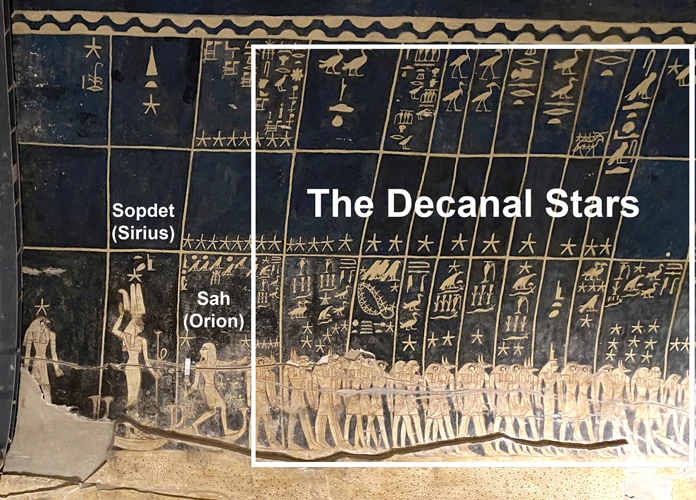The celestial world has captivated humanity for centuries, fascinating individuals with its enigmatic beauty and profound influence. Among the ancient civilizations that delved into the secrets of the stars, few are as awe-inspiring as Ancient Egypt. From the construction of colossal pyramids to the intricate symbolism in their artworks, the ancient Egyptians revered celestial bodies and believed in the profound impact they had on every aspect of life. In this article, we will explore the captivating world of astrology in Ancient Egypt, unraveling the mysteries that lie within the cosmic tapestry and uncovering the profound significance it held in the lives of the Egyptian people. Join us on a journey through time as we delve into the origins of astrology in Ancient Egypt, the significance of the Egyptian zodiac, the role of astrology in Pharaonic rule, the techniques used by ancient Egyptian astrologers, the depictions of astrology in art and its connection to ancient Egyptian religion. So, sit back and prepare to be amazed as we unravel the secrets of the stars and the legacy they left behind in the land of the Pharaohs.
The Beginnings of Astrology in Ancient Egypt
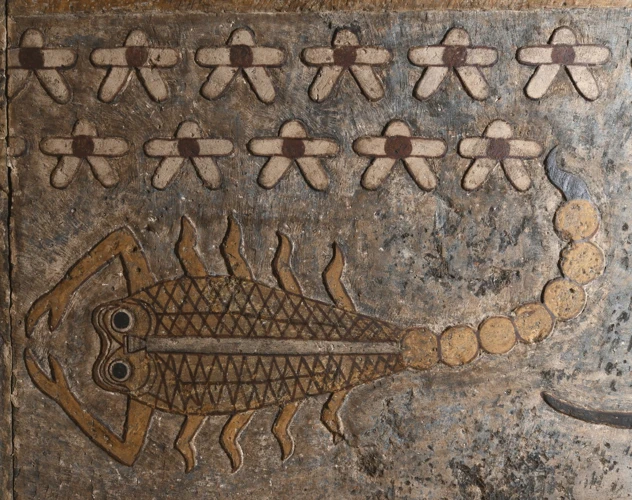
Astrology in Ancient Egypt has its roots in the earliest civilizations of the Nile Valley. The ancient Egyptians were keen observers of the celestial bodies, forging a deep connection between the movements of the stars and their daily lives. It is believed that astrology began to take shape as early as the 3rd millennium BCE, with the Egyptians developing a system of celestial omens and divination. They believed that the positions and alignments of the planets, stars, and other celestial entities could reveal insights about the past, present, and future. Astrology played a crucial role in various aspects of ancient Egyptian society, including agriculture, natural disasters, and even the pharaoh’s reign. The ancient Egyptians associated specific deities with celestial bodies, believing that these gods had an influence on the events unfolding on Earth. They believed that by understanding the movements of the stars, they could gain insight and guidance in navigating their lives. The knowledge and practice of astrology were passed down through generations of priests and scribes, becoming an integral part of Egyptian culture and spirituality. As we delve further into the intricacies of astrology in Ancient Egypt, we will explore the fascinating zodiac system and its significance in understanding the complexities of this ancient civilization. So, let us journey back in time to unravel the beginnings of astrology in Ancient Egypt, exploring a world where the stars held the key to unraveling the secrets of the universe.
Ancient Egyptian Zodiac and Its Significance
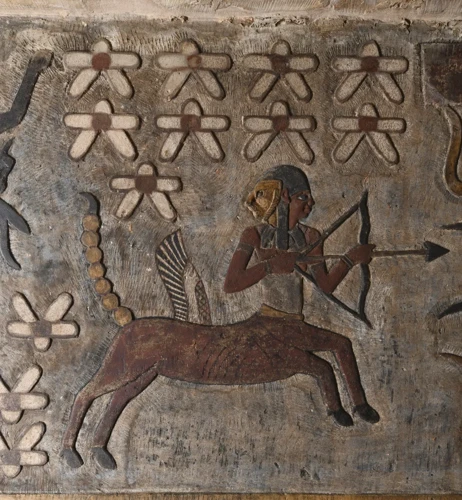
The Ancient Egyptian Zodiac holds a significant place in the realm of astrology in Ancient Egypt. It consisted of twelve distinct signs, each associated with certain qualities and characteristics. These signs were deeply connected to the natural world and the spiritual beliefs of the Egyptians. The twelve Egyptian Zodiac signs were: Amon-Ra, Apis, Maat, Anubis, Seth, Hathor, Osiris, Amun, Thoth, Bastet, Isis, and Horus. Each sign represented a specific deity or aspect of Egyptian mythology and carried symbolic meanings. For example, the Amon-Ra sign symbolized power and authority, while the Maat sign represented balance and justice. The Ancient Egyptian Zodiac played a vital role in various aspects of Egyptian life, including agriculture, medicine, and even decision-making processes. Understanding one’s zodiac sign provided insight into personal strengths, weaknesses, and potential paths for growth. The significance of the Egyptian Zodiac in Ancient Egypt was a testament to the profound belief in the interconnectedness of the cosmos and human existence. To gain a deeper understanding of the zodiac’s role in ancient cultures, you can also explore astrology in Greek mythology, Mesopotamian culture, and ancient China.
The Twelve Egyptian Zodiac Signs
The Twelve Egyptian Zodiac Signs were an essential part of ancient Egyptian astrology, representing different periods of the year and corresponding to specific deities. Each sign was associated with unique qualities and characteristics that influenced individuals born under them.
1. Amon-Ra: Represented by a ram, people born under this sign were believed to possess leadership qualities and a strong will.
2. Shu: Symbolized by the air, those born under this sign were seen as intelligent, analytical, and logical thinkers.
3. Tefnut: Personified by moisture, individuals born under this sign were considered to be calm, empathetic, and nurturing.
4. Geb: Linked with the earth, those born under this sign were thought to be practical, grounded, and in tune with nature.
5. Nut: Represented by the sky, people born under this sign were believed to be dreamers, intuitive, and imaginative.
6. Osiris: Symbolized by the ruler of the underworld, individuals born under this sign were seen as wise, just, and protective.
7. Isis: Personified by the goddess of magic and wisdom, those born under this sign were believed to be nurturing, compassionate, and intuitive.
8. Seth: Associated with chaos and storms, people born under this sign were seen as strong-willed, ambitious, and independent.
9. Horus: Symbolized by the falcon, those born under this sign were believed to be courageous, visionary, and protective.
10. Anubis: Linked with the jackal, individuals born under this sign were thought to have a strong sense of justice, loyalty, and determination.
11. Bastet: Personified by the lioness, those born under this sign were seen as fierce, passionate, and protective.
12. Sekhmet: Represented by the lioness goddess, people born under this sign were believed to be powerful, confident, and assertive.
These zodiac signs held great significance in ancient Egyptian society, providing insight into personality traits, compatibility, and life paths. By understanding their zodiac sign, individuals could gain a deeper understanding of themselves and their connection to the celestial forces that governed their lives. It is important to note that the ancient Egyptian zodiac has similarities to other zodiac systems, such as the Greek, Mesopotamian, and Chinese zodiacs, showcasing the universality of astrological beliefs throughout different cultures and civilizations.
Symbolism and Interpretations
The Egyptian zodiac system consisted of twelve signs, each embodying different symbolic meanings and interpretations. Let’s delve into the symbolism and interpretations associated with each sign:
1. The Nile (Born: January 1-7, June 19-28, September 1-7) – Representing the river that sustained and nourished Egypt, those born under the sign of the Nile were seen as adaptable, nurturing, and resourceful.
2. Amon-Ra (Born: January 8-21, February 1-11) – Associated with the sun god Amon-Ra, individuals born under this sign were believed to possess qualities such as leadership, confidence, and charisma.
3. Mut (Born: January 22-31, September 8-22) – Symbolizing the ancient Egyptian mother goddess, those born under the sign of Mut were considered nurturing, protective, and emotionally intuitive.
4. Geb (Born: February 12-29, August 20-31) – Representing the earth, individuals born under the sign of Geb were seen as grounded, practical, and reliable.
5. Osiris (Born: March 1-10, November 27-December 18) – Linked to the god of the afterlife and rebirth, those born under the sign of Osiris were believed to possess qualities of regeneration, transformation, and strong intuition.
6. Isis (Born: March 11-31, October 18-29, December 19-31) – Associated with the goddess of magic and wisdom, individuals born under the sign of Isis were seen as intuitive, intelligent, and deeply spiritual.
7. Thoth (Born: April 1-19, November 8-17) – Symbolizing wisdom and knowledge, those born under the sign of Thoth were believed to possess excellent communication skills, a sharp intellect, and a thirst for discovery.
8. Horus (Born: April 20-May 7, August 12-19) – Linked to the sky god Horus, individuals born under this sign were seen as bold, assertive, and courageous leaders.
9. Anubis (Born: May 8-27, June 29-July 13) – Representing the god of the dead and the afterlife, those born under the sign of Anubis were believed to possess traits such as discipline, loyalty, and a strong sense of justice.
10. Seth (Born: May 28-June 18, September 28-October 2) – Associated with chaos and unpredictability, individuals born under the sign of Seth were seen as cunning, ambitious, and capable of both great achievements and destructive tendencies.
11. Bastet (Born: July 14-28, September 23-27, October 3-17) – Symbolizing the goddess of home, fertility, and protection, those born under the sign of Bastet were believed to possess nurturing qualities, love for family, and a strong desire for harmony.
12. Sekhmet (Born: July 29-August 11, October 30-November 7, December 28-31) – Linked to the powerful lioness goddess, individuals born under the sign of Sekhmet were seen as fierce, independent, and protective of their loved ones.
These interpretations provided the ancient Egyptians with a framework for understanding their personalities, strengths, and weaknesses. They believed that by aligning themselves with the celestial energies associated with their birthsign, they could navigate life’s challenges and fulfill their destined purpose. The symbolism and interpretations of the Egyptian zodiac continue to fascinate and inspire us today, offering a deeper understanding of the ancient Egyptian culture and their intricate relationship with the cosmos.
Astrology and the Pharaohs
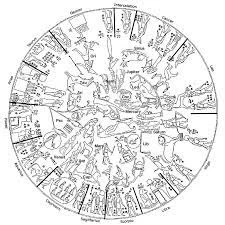
In the realm of ancient Egypt, astrology held a prominent position in the lives of the pharaohs, the revered rulers of this grand civilization. Astrology played a significant role in pharaonic rule, shaping decisions, and guiding the actions of the pharaohs. The ancient Egyptians believed that the pharaoh was the embodiment of a divine being on Earth, and therefore, the alignment of the stars and the planets had a direct impact on their reign. It was essential for the pharaohs to consult astrologers and priests to gain insights into their legitimacy as rulers, the prosperity of their kingdom, and the well-being of their people. The pharaohs sought astronomical knowledge not only for guidance but also for protection from a celestial perspective. Astrology provided the pharaohs with a tool to ensure the favor of the gods and exert their authority over the kingdom. By understanding the celestial forces at play, the pharaohs aimed to harmonize their rule with the cosmic energy and ensure the success of their reign. As we unravel the intricate connection between astrology and the pharaohs, we gain a deeper understanding of the profound influence and symbolism associated with ancient Egyptian rulership.
The Role of Astrology in Pharaonic Rule
The role of astrology in Pharaonic rule was deeply ingrained in the ancient Egyptian civilization. The pharaohs, who were believed to be divine rulers with a direct connection to the gods, relied heavily on astrology to validate their legitimacy and guide their decisions. Astrology played a crucial role in determining the pharaoh’s auspicious and inauspicious days, which had a direct impact on the administration of the kingdom. According to ancient Egyptian beliefs, the pharaoh’s success and the prosperity of the kingdom were intertwined with the alignment and movements of the celestial bodies.
Astrologers in the pharaoh’s court closely monitored the positions of the planets, stars, and other celestial phenomena to provide guidance to the rulers. The pharaohs would consult astrologers before making important decisions such as starting military campaigns, building monuments, or embarking on grand construction projects. The alignment of the stars was seen as a reflection of the gods’ will, and the pharaohs would heed these celestial messages to ensure their actions were in harmony with the divine plan.
Additionally, astrology played a significant role in the pharaoh’s ascension to the throne. The pharaoh’s birth chart, which was created by casting horoscopes based on the time and date of their birth, played a crucial role in determining the pharaoh’s fate, character, and potential rulership. Astrologers would interpret these birth charts to identify favorable and unfavorable aspects that would shape the pharaoh’s destiny and guide their reign.
The guidance provided by astrology was not limited to the pharaohs alone but also extended to the ruling class and high-ranking officials. It was believed that by aligning their actions with the movements of the celestial bodies, the pharaohs and their court could maintain order, ensure prosperity, and protect the kingdom from chaos and strife.
Astrology held a central position in ancient Egyptian society, particularly in the realm of pharaonic rule. By consulting astrologers and studying the celestial phenomena, the pharaohs sought guidance from the gods and aligned their decisions with the cosmic forces. Astrology played a pivotal role in determining auspicious moments, validating the pharaoh’s legitimacy, and guiding their reign. It was a powerful tool that helped shape the destiny of the pharaohs and the kingdom as a whole.
Astrological Practices for Royal Succession
Astrological Practices for Royal Succession played a crucial role in the dynastic rule of Ancient Egypt. The pharaoh, as the divine ruler, needed to ensure a smooth transition of power from one generation to the next. To achieve this, astrological practices were employed to determine the most auspicious time for the birth of a future king or queen. The ancient Egyptians believed that the alignment of celestial bodies at the moment of birth could reveal important insights about the individual’s destiny and suitability for ruling.
One method used in astrological practices for royal succession was the examination of the alignment of stars and planets at the time of conception. The alignment had to be favorable to ensure the birth of a future pharaoh who possessed the necessary qualities to rule justly and effectively. Additionally, the position of specific constellations and their relationship to the ruling deity associated with the pharaoh were also taken into account. These factors would determine the legitimacy and potential success of the future ruler.
Astrologers would analyze the natal chart of the newborn heir, which included the positions of the sun, moon, planets, and other celestial bodies at the exact moment of birth. The interpretation of this chart provided insights into the individual’s strengths, weaknesses, and potential challenges. This information was used to guide the pharaoh in the upbringing and education of the heir, ensuring their preparedness for the responsibilities of rulership.
The astrological practices for royal succession extended beyond birth, as important celestial events such as planetary alignments and eclipses were also considered during the coronation and reign of the pharaoh. These events were seen as cosmic omens, influencing the prosperity and stability of the kingdom. The pharaoh would consult with astrologers to ensure that significant ceremonies and important decisions were carried out during favorable celestial alignments.
Astrology played a vital role in determining the succession of rulers in Ancient Egypt. The alignment of the stars and planets was carefully observed during the conception, birth, and subsequent reign of the pharaoh. Through these astrological practices, the ancient Egyptians sought to ensure the legitimacy and success of their divine rulers, creating a harmonious connection between the heavens and the earthly realm.
Ancient Egyptian Astrologers and Their Techniques
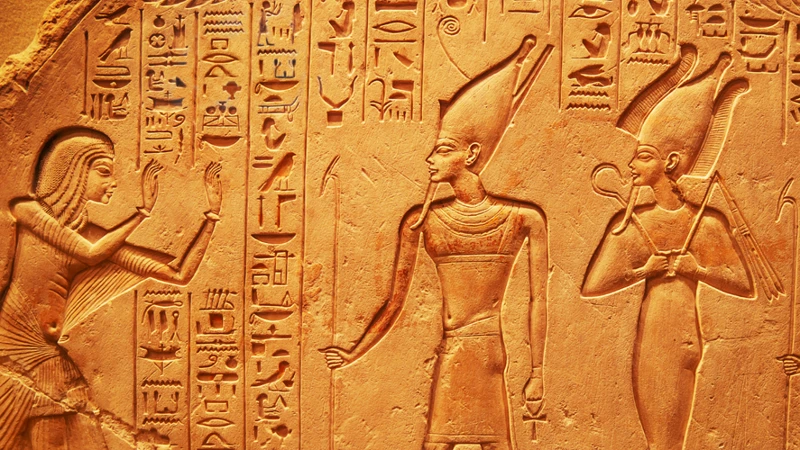
Ancient Egyptian Astrologers were highly respected and revered individuals in society, known for their profound knowledge of the stars and their ability to interpret the celestial messages. These astrologers were often priests or scribes who dedicated their lives to studying the movements of the celestial bodies and uncovering the secrets of the universe. They employed various techniques and tools to aid their observations and calculations. One such technique was the construction of astrological charts, which involved mapping the positions of the planets and stars at specific times and locations. These charts served as a guide for astrologers to make predictions and interpretations based on the alignment of celestial bodies. In addition to charts, astrologers used instruments such as sundials and merkets (a form of portable sundial) to track the movement of the Sun and other stars. These tools allowed them to determine the time of day and night, which was crucial for accurate astrological readings. Astrologers in Ancient Egypt also relied on their vast knowledge of mythology and religious texts to interpret the symbolism behind celestial events and relate them to earthly affairs. Their techniques combined mathematical calculations, astronomical observations, and a deep understanding of Egyptian cosmology. The expertise and wisdom of these astrologers were highly sought after, and their insights influenced decision-making in various domains, including agriculture, medicine, and politics. The legacy of ancient Egyptian astrology lives on through their enduring techniques, reminding us of the profound connection between humanity and the cosmos.
The Known Astrologers of Ancient Egypt
The practice of astrology in Ancient Egypt was led by esteemed individuals who possessed deep knowledge and understanding of the celestial realm. While specific names of astrologers from this time are scarce, there are records of notable figures who played significant roles in the field. One renowned astrologer was Nechepso, an Egyptian priest and astrologer who lived during the 4th century BCE. Nechepso is famous for his work on astrological predictions and his collaboration with Petosiris, another prominent astrologer of the time. Their collaborative efforts resulted in the creation of an influential astrological treatise known as the “Nechepso-Petosiris.” This text became highly regarded and was widely studied by later generations.
Another notable figure in ancient Egyptian astrology is Dendera’s unnamed astrologer. The Dendera Zodiac, an ancient artifact depicting the constellations and celestial bodies, was discovered within the temple complex of Dendera. It is believed that the astrologer who created this remarkable depiction of the zodiac possessed a profound understanding of cosmic alignments and their significance. The Dendera Zodiac showcases the ancient Egyptians’ deep connection to astrology and their ability to represent celestial phenomena in their art.
While the identities of many ancient Egyptian astrologers remain elusive, these notable figures provide glimpses into the rich tradition of astrology in Ancient Egypt. Their contributions to the field continue to fascinate and inspire modern scholars and astrology enthusiasts alike, offering a window into the complex and sophisticated astrological practices of this ancient civilization.
Methods and Tools Used in Ancient Egyptian Astrology
Methods and tools used in ancient Egyptian astrology were a culmination of meticulous observations and mathematical calculations. Ancient Egyptian astrologers employed various techniques and instruments to study the heavens. One of the primary tools used was the astrolabe, a complex instrument consisting of a rotating disk with marked positions for celestial bodies. The astrolabe allowed astrologers to determine the precise positions of stars and planets at specific times. Additionally, ancient Egyptian astrologers utilized the merkhet, a simple instrument resembling a plumb line with a weighted string, to measure the alignment of stars and celestial bodies with the horizon. The merkhet helped in recording the rising and setting of stars, which were essential for predicting auspicious and inauspicious celestial events. Another commonly used tool in ancient Egyptian astrology was the sundial, which allowed astrologers to measure the movement of the sun throughout the day. These measurements were crucial in determining the time of various celestial phenomena and aligning them with important events on Earth. Mathematical calculations were integral to ancient Egyptian astrology. Astrologers relied on a system of numerology and precise mathematical calculations to interpret the positions and movements of celestial bodies. They meticulously recorded astronomical data, such as the rising and setting times of stars and planets, and developed tables and charts to aid in their astrological predictions. Astrologers also examined the movement of specific constellations and their correspondence with certain prophetic events. The complex interplay of observation, mathematical calculations, and divination techniques allowed ancient Egyptian astrologers to unravel the mysteries of the cosmos and make predictions about the future. As we uncover more about the methods and tools employed by ancient Egyptian astrologers, we gain a deeper appreciation of their dedication and ingenuity in deciphering the secrets of the stars.
Depictions of Astrology in Ancient Egyptian Art
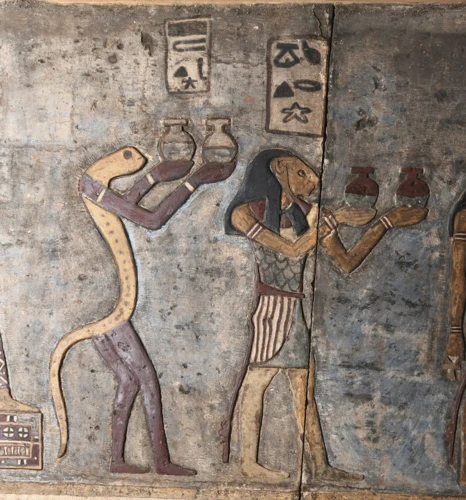
Ancient Egyptian art provides a mesmerizing window into the world of astrology and its significance in their culture. Depictions of astrology can be found in various forms of artistic expression, such as temple carvings and tomb paintings. In temple carvings, the zodiac signs were often depicted in intricate detail, showcasing the harmony between the celestial and earthly realms. Each sign was represented by an animal or a deity, symbolizing its unique qualities and characteristics. These representations served not only as decorative elements but also as a means to communicate the importance of astrology in guiding daily life. Additionally, astrological symbols were often featured in tomb paintings, where they were believed to provide protection and guidance for the deceased in the afterlife. The intricate details and symbolism present in these artistic depictions reflect the deep reverence and belief in astrology held by the ancient Egyptians. By exploring the rich artistic heritage of Ancient Egypt, we can gain valuable insights into their profound relationship with the stars and the role astrology played in shaping their worldview.
Zodiac Representations in Temple Carvings
Zodiac representations in temple carvings offer a fascinating glimpse into the ancient Egyptian understanding and reverence for astrology. These intricate carvings can be found in temples throughout Egypt, such as the iconic Temple of Karnak and the Temple of Luxor. These depictions typically show the twelve Egyptian zodiac signs, each represented by an animal, and are believed to have served multiple purposes. Firstly, they acted as a visual representation of the zodiac system, providing a reference point for astrological interpretation and divination. Additionally, these carvings served a religious and symbolic purpose, highlighting the cosmic order and the interconnectedness of the divine and earthly realms. The zodiac signs were often associated with specific deities, further emphasizing their significance in ancient Egyptian religion and cosmology. These temple carvings demonstrate the importance placed on astrology in Ancient Egypt, as they were prominently displayed in sacred spaces dedicated to worship and spiritual practices. They are a testament to the profound impact astrology had on the daily lives and belief systems of the ancient Egyptians. Exploring these temple carvings allows us to delve deeper into the symbolism, artistry, and cultural significance of astrology in ancient Egyptian society, painting a vivid picture of a civilization deeply connected to the celestial realm.
Astrological Symbols in Tomb Paintings
Astrological symbols in tomb paintings provide a fascinating glimpse into the beliefs and practices surrounding astrology in Ancient Egypt. The ancient Egyptians incorporated these symbols into their funerary art, emphasizing the importance of astrology in their preparation for the afterlife. When exploring these murals, one can find a rich array of astrological symbols that depict celestial bodies, zodiac signs, and other elements associated with astrology. Among the most common symbols found in tomb paintings are representations of the sun, moon, and stars, which are essential components of the Egyptian astrological system. The sun symbolized life and rebirth, often depicted as a radiant disc with outstretched wings. The moon, on the other hand, represented fertility and the passage of time. It was typically depicted as a crescent or a full moon. Another prominent symbol found in tomb paintings is the constellation of Orion, which held significant meaning in Egyptian mythology and was believed to guide the souls of the deceased to the afterlife. This celestial connection between the stars and the journey to the afterlife reinforces the belief in the transformative power of astrology. Additionally, individual tombs may feature specific zodiac signs, such as Taurus or Leo, which were linked to the deceased individual’s birth or the desired cosmic influences for their journey in the afterlife. These astrological symbols were carefully painted and placed within the tombs, serving as a guide and a source of spiritual protection throughout the soul’s eternal journey. As we examine these tomb paintings and decipher their astrological symbolism, we gain a deeper understanding of the profound role astrology played in ancient Egyptian beliefs and traditions, immersing ourselves in a world where the stars interwove with the fabric of life and death.
Astrology and Ancient Egyptian Religion
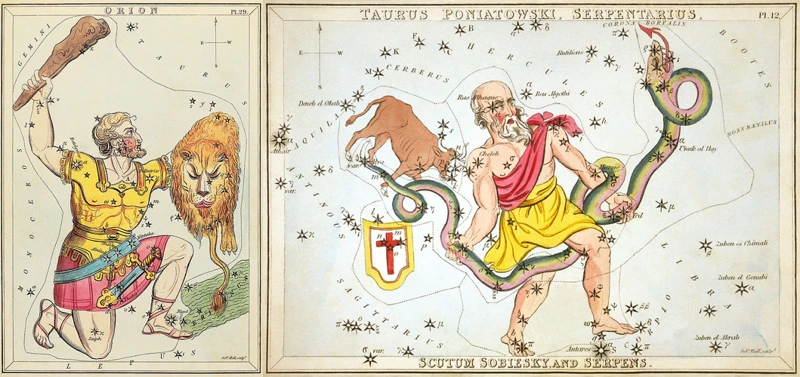
Astrology played a significant role in ancient Egyptian religion, intertwining the celestial realm with the divine pantheon worshipped by the Egyptian people. The ancient Egyptians believed that the movements and alignments of the stars and planets were directly connected to the actions and influences of their gods and goddesses. Each celestial body was associated with a specific deity, and their positions were believed to hold immense power and significance. For example, they associated the sun with the powerful god Ra, believing that Ra’s journey across the sky each day represented the cycle of life, death, and rebirth. Similarly, the moon was linked to the goddess Isis, symbolizing fertility and the maternal aspect of creation. The alignment of specific celestial bodies during certain religious ceremonies was seen as a powerful moment of connection between the earthly and divine realms. Astrology was deeply intertwined with religious rituals and ceremonies, guiding the timing of events and offering insights into divine will. The ancient Egyptians would consult astrologers to interpret celestial signs and align their actions with the will of the gods. This sacred connection between astrology and religion further underscores the profound influence of the stars on every aspect of ancient Egyptian life.
Astrological Connections to Deities
Astrology in Ancient Egypt was deeply intertwined with their religious beliefs and the worship of various deities. The ancient Egyptians believed that celestial bodies were not just astronomical entities but also embodied the power and influence of specific gods and goddesses. Each deity was associated with a particular planet, star, or constellation, and their movements were believed to reflect the actions and will of these divine beings. Understanding the astrological connections to deities was essential in interpreting celestial events and their impact on human affairs.
Here are some of the significant astrological connections to deities in Ancient Egypt:
1. Ra (The Sun God): Ra was the most important deity in the Egyptian pantheon, representing the Sun. The rising and setting of the Sun were seen as Ra’s daily journey through the sky, and his movements influenced the cycles of life and death.
2. Horus (The Sky God): Horus, one of the most revered gods, was associated with the planet Venus. The appearance and disappearance of Venus in the morning and evening skies were believed to symbolize the cycles of birth, death, and resurrection.
3. Thoth (The God of Wisdom): Thoth was connected to the Moon and its phases. He was considered the keeper of knowledge and the divine scribe, governing the ebb and flow of time, writing destiny, and guiding souls in the afterlife.
4. Osiris (The God of the Dead): Osiris, the god of the afterlife, was associated with the constellation Orion. The annual rising of Orion in the night sky marked Osiris’s rebirth and symbolized the resurrection and eternal life.
5. Anubis (The God of Embalming): Anubis was linked to the star Sirius, also known as the Dog Star. The heliacal rising of Sirius, occurring just before the annual flooding of the Nile, was seen as a sign of Anubis’s protection over the deceased and the fertility of the land.
These are just a few examples of the intricate astrological connections to deities in Ancient Egypt. Each god and goddess had their celestial counterpart, and deciphering their movements and alignments was crucial in understanding their divine messages and influence over human destiny. The ancient Egyptians viewed astrology as a means to commune with their gods, seek guidance, and ensure divine favor in their lives. The celestial dance of the stars was seen as a reflection of the divine order that governed the universe, and their connection to deities added a profound spiritual dimension to the practice of astrology in Ancient Egypt.
Role of Astrology in Religious Ceremonies
The role of astrology in religious ceremonies held profound importance in ancient Egyptian culture. Astrology was deeply intertwined with their religious beliefs and rituals, symbolizing the connection between the celestial and divine realms. The ancient Egyptians believed that the movement of the stars and planets directly influenced the actions and decisions of their deities. As a result, astrology played a crucial role in determining the timing and auspiciousness of religious ceremonies. Priests and astrologers carefully observed celestial events such as planetary alignments, solstices, and equinoxes to determine the most favorable times for conducting religious rituals and sacrifices. They believed that performing these ceremonies during celestial alignments would enhance the connection between the mortal world and the gods, ensuring the favor and blessings of the deities. The priests, who were skilled in the interpretation of astrological signs, used their knowledge to guide the pharaohs and the population in religious practices. The celestial alignment of stars and planets also served as a reminder of the eternal nature of the gods and the cosmic order they maintained. Astrology in religious ceremonies served not only as a practical tool for scheduling rituals but also as a means of fostering a spiritual connection and strengthening the religious beliefs of the ancient Egyptians. The intricate interplay between astrology and religion in ancient Egypt highlights the deep reverence and importance placed on the celestial world in their daily lives and demonstrates the belief that the gods and the stars were intricately linked, guiding and influencing every aspect of their existence.
Astrology’s Influence on Daily Life

Astrology in Ancient Egypt exerted a profound influence on the daily lives of the Egyptian people. It was deeply ingrained in their society, shaping their decisions, actions, and even their health. Astrological divinations and predictions played a pivotal role in guiding individuals through important life events and determining the most propitious times for various activities, such as marriage, childbirth, and travel. The Egyptians believed that aligning their actions with the cosmic energies would bring them favorable outcomes and protect them from harm. Astrology also influenced medical practices in Ancient Egypt. Physicians utilized astrological charts to determine the underlying causes of illnesses and to choose the most effective treatments. For example, if a patient was suffering from a stomach ailment, the physician would consult astrological charts to identify the celestial influences that might be affecting the patient’s digestive system. By aligning their medical interventions with the cosmic rhythms, the ancient Egyptians believed they could facilitate the healing process. The influence of astrology permeated every aspect of daily life, providing guidance and reassurance as individuals navigated their earthly existence.
Astrological Divinations and Predictions
Astrological divinations and predictions were an integral part of daily life in Ancient Egypt. The ancient Egyptians believed that the celestial bodies held the power to foretell the future and provide guidance in making important decisions. Astrologers, known as “scryers,” would interpret the positions of the stars and planets to offer insights into various aspects of life, including love, health, and success. One popular divination technique was called “astrological casting,” where astrologers would cast lots and interpret the patterns formed to reveal hidden messages from the gods. These divinations often took place in sacred temples, where the scryers would commune with the divine and seek their guidance through the language of the stars. Astrological predictions were not limited to individuals; they extended to the realm of politics and society as well. For instance, astrology played a role in determining the most auspicious time for military campaigns or important state events. The ancient Egyptians firmly believed in the power of astrology and its ability to shape their lives. It provided them with a sense of comfort, guidance, and a means to make informed decisions. While astrology in Ancient Egypt was deeply intertwined with spirituality, it was also viewed as a practical tool for navigating the complexities of life. The influence of astrology can still be seen today, as many people continue to seek astrological guidance for insights into their lives and the world around them. So, whether you are a believer or a skeptic, the role of astrology in the divinations and predictions of ancient Egyptian society cannot be denied.
Use of Astrology in Medical Practices
The ancient Egyptians believed that astrology not only influenced their spiritual and daily lives but also played a crucial role in their medical practices. The use of astrology in medical treatments was based on the belief that the positions of celestial bodies could impact a person’s health and well-being. The ancient Egyptian physicians, who were highly skilled in their medical knowledge, incorporated astrological principles into their treatments.
One way astrology was utilized in medical practices was through the concept of “horary astrology.” Horary astrology involved determining the most auspicious time to administer treatments or perform surgeries based on the astrological positions at that specific moment. The time at which the treatment was undertaken was considered essential in ensuring its effectiveness and success. For example, if a patient needed surgery, the ancient Egyptian physician would consult the planetary positions to determine the most propitious time for the procedure, ensuring better outcomes.
Astrology also played a role in diagnosing and treating ailments. The ancient Egyptian physicians would analyze a patient’s astrological birth chart, which detailed the positions of the planets at the time of their birth. By studying this chart, they believed they could gain insight into the person’s predispositions, vulnerabilities, and potential health issues. This knowledge guided the physicians in providing personalized care and developing treatment plans based on the specific astrological influences affecting the patient.
Additionally, astrology influenced the use of medicinal herbs and plants in ancient Egyptian medicine. The belief was that certain plants held a connection to specific celestial bodies and could harness their healing properties. The ancient Egyptian physicians would consider the astrological correspondences of plants and their associated planets when prescribing herbal remedies. For example, a plant associated with the Sun may be used to treat ailments associated with vitality and energy.
It is important to note that while astrology played a significant role in ancient Egyptian medical practices, their physicians also possessed extensive knowledge of anatomy, physiology, and herbal medicine. The inclusion of astrology in medical treatments was seen as an additional layer of understanding and treatment, complementing their broader medical expertise.
The use of astrology in medical practices showcases the deep intertwining of spiritual beliefs and practical applications in ancient Egyptian culture. It highlights their holistic approach to healthcare, where the alignment of the stars was considered vital in maintaining well-being and promoting healing. So, whether it was selecting an auspicious time for a surgery or prescribing herbal remedies aligned with celestial influences, astrology held a prominent place in ancient Egyptian medical practices, reflecting their belief in the interconnectedness of the cosmos and human health.
Decline and Resurgence of Ancient Egyptian Astrology
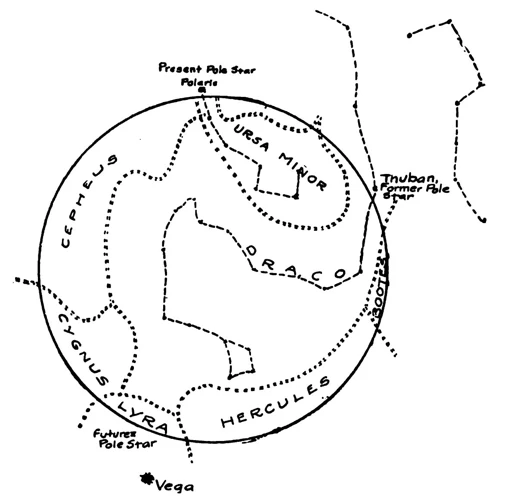
After flourishing for centuries, astrology in Ancient Egypt experienced a period of decline and resurgence. The decline of ancient Egyptian astrology can be attributed to a combination of factors. Firstly, the conquest of Egypt by foreign powers, such as the Persians and the Greeks, brought new cultural influences that overshadowed the indigenous practices. The Greek period brought with it the introduction of Hellenistic astrology, which merged with Egyptian astrology, giving birth to a new form of celestial divination. Additionally, with the rise of Christianity in the Roman Empire, Egypt underwent a profound religious transformation, leading to the suppression and gradual abandonment of ancient Egyptian beliefs and practices.
However, despite the decline, ancient Egyptian astrology experienced a resurgence in the modern era. The discoveries of ancient texts and archaeological findings sparked a renewed interest in the wisdom and knowledge of the ancient Egyptians. Scholars and enthusiasts began to delve into the surviving texts, such as the Cairo Calendar and the Book of the Day and Night, to decipher the intricate astrological techniques employed by the ancient Egyptians.
In the 20th century, as Egypt gained independence and a rejuvenated sense of cultural identity, there was a renewed focus on ancient Egyptian heritage. Astrologers and researchers began to explore the rich astrological traditions of ancient Egypt, delving into translations, comparative studies, and reconstructing ancient methods of chart calculation and interpretation.
Today, ancient Egyptian astrology continues to captivate the interest of astrologers, historians, and enthusiasts alike. Its unique blend of celestial observations, religious symbolism, and cultural practices provides a fascinating glimpse into the ancient Egyptian worldview. While it may not hold the same widespread influence and popularity as modern astrology, the legacy of ancient Egyptian astrology lives on, serving as a reminder of the timeless fascination that humanity has had with the stars and their powerful influence on our lives.
The Legacy of Ancient Egyptian Astrology
The legacy of Ancient Egyptian astrology is one that has left an indelible mark on human history. Despite the decline of Ancient Egyptian civilization, the influence and teachings of their astrological practices continued to resonate through the ages. The knowledge and wisdom imparted by Egyptian astrologers influenced the development of astrology in neighboring cultures, such as Greece and Mesopotamia, which further refined and expanded upon the foundations laid by the Egyptians. Greek astrology, for example, drew heavily from Egyptian astrological knowledge and incorporated it into their own mythological framework, creating a unique blend of astrology and mythology. The influence of Egyptian astrology can also be seen in ancient Chinese astrology, as trade and cultural exchange between Egypt and China facilitated the transmission of astrological ideas and practices. The enduring legacy of Ancient Egyptian astrology is also evident in the modern-day fascination with astrology. Despite the rise and fall of empires, the understanding that the movements of the stars hold profound meaning and insights about our lives has persisted throughout the centuries. People from all corners of the globe continue to consult horoscopes, study their birth charts, and seek guidance from the stars. The enduring fascination with Ancient Egyptian astrology speaks to the timeless appeal and enduring relevance of this ancient wisdom. As we reflect on the legacy of Ancient Egyptian astrology, we are reminded of the human desire to seek meaning and connection within the vastness of the cosmos. It serves as a testament to the profound impact that celestial observations made by our ancestors can have on shaping the way we perceive and understand ourselves in the present day.
Conclusion
In conclusion, astrology in Ancient Egypt was an intricate and deeply embedded aspect of their culture and society. The ancient Egyptians believed that the movements of the stars and planets held profound significance and could provide insights into various aspects of life. From the beginnings of astrology in the early civilizations of the Nile Valley to its influence on Pharaonic rule and daily life, astrology played a pivotal role. The Egyptian zodiac, with its twelve signs and intricate symbolism, provided a framework for understanding personality traits, predicting outcomes, and guiding decisions. Astrologers in ancient Egypt employed various techniques and tools to interpret celestial patterns and make predictions. Depictions of astrology in ancient Egyptian art further emphasized its significance, with zodiac representations adorning temple carvings and astrological symbols gracing tomb paintings. Astrology was closely intertwined with ancient Egyptian religion, connecting celestial bodies to specific deities and playing a role in religious ceremonies. The practice of astrology permeated many aspects of daily life, from divinations and predictions to medical practices. While the decline of ancient Egyptian astrology occurred over the centuries, its legacy continues to this day, with remnants of its influence found in modern astrology. The enigmatic world of astrology in Ancient Egypt leaves us with a deep appreciation for the human quest to understand the cosmos and uncover the secrets of the stars.
Frequently Asked Questions
1. How did astrology influence everyday life in Ancient Egypt?
Astrology played a significant role in the daily lives of ancient Egyptians. They believed that the positions and movements of celestial bodies influenced various aspects of life, including agriculture, natural disasters, and personal fortunes. Astrology provided guidance and insight, helping individuals make important decisions and navigate their paths.
2. Were there specific astrological practices for royal succession?
Yes, astrology played a crucial role in determining royal succession in ancient Egypt. Pharaohs sought the guidance of astrologers to choose the ideal successor based on astrological readings. Specific birth dates and celestial alignments were considered to ensure a prosperous and successful reign.
3. Who were some of the notable astrologers of Ancient Egypt?
While specific names may be lost to time, ancient Egyptian society boasted skilled astrologers who held positions of prestige and importance. These individuals were typically priests or scribes who possessed deep knowledge of the stars and were responsible for interpreting celestial omens and providing astrological guidance.
4. What tools and methods did ancient Egyptian astrologers use in their practice?
Ancient Egyptian astrologers utilized a variety of tools and methods to practice their craft. They relied on instruments such as astrolabes and sundials to observe the position of celestial bodies. They also meticulously recorded celestial events and alignments, allowing them to make predictions and interpretations.
5. How did astrology connect to ancient Egyptian religion?
Astrology had strong connections to ancient Egyptian religion. The Egyptians associated specific deities with celestial bodies, believing that these gods held sway over various aspects of life. Astrological events were often incorporated into religious ceremonies, and interpretations of celestial phenomena were intertwined with religious beliefs.
6. What were the astrological divinations and predictions made in Ancient Egypt?
Ancient Egyptian astrologers made various divinations and predictions based on celestial observations. These included forecasting agricultural success, predicting the outcomes of battles and wars, and providing personal horoscopes for individuals. Astrology was deeply embedded in their culture, and its predictions influenced decision-making at both personal and societal levels.
7. Did astrology have a role in ancient Egyptian medical practices?
Astrology played a significant role in ancient Egyptian medical practices. Physicians often consulted astrological charts to guide diagnosis and treatment. They believed that specific celestial alignments influenced the body’s internal balance, and astrology helped determine the most auspicious times for medical procedures.
8. How did the depiction of astrology manifest in ancient Egyptian art?
Astrology was visually represented in various forms of ancient Egyptian art. Zodiac signs were depicted in temple carvings, showcasing the celestial significance in religious contexts. Astrological symbols also appeared in tomb paintings, emphasizing the belief that the stars held profound importance in both life and death.
9. What led to the decline of ancient Egyptian astrology?
The decline of ancient Egyptian astrology can be attributed to several factors. The conquest of Egypt by foreign powers and the adoption of new religious beliefs diminished the prominence of astrology. Additionally, the rise of Greek and Roman cultures brought forth astrology’s integration with their own systems, leading to a shift away from the traditional Egyptian practices.
10. How does the legacy of ancient Egyptian astrology continue to inspire us today?
Ancient Egyptian astrology has left an enduring legacy. Its influence is still felt in modern astrology, with concepts such as zodiac signs and celestial symbolism originating in ancient Egyptian practices. The fascination with the stars and their connection to human destiny continues to captivate and inspire individuals around the world, preserving the rich heritage of this ancient civilization.

